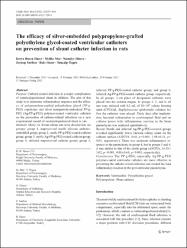| dc.description.abstract | Catheter-related infection is a major complication of ventriculoperitoneal shunt in children. The aim of this study is to determine inflammatory response and the efficacy of polypropylene-grafted polyethylene glycol (PP-g-PEG) copolymer and silver nanoparticle-embedded PP-g-PEG (Ag-PP-g-PEG) polymer-coated ventricular catheters on the prevention of catheter-related infections on a new experimental model of ventriculoperitoneal shunt in rats. Thirty six Wistar albino rats were divided into six groups: group 1, unprocessed sterile silicone catheter-embedded group; group 2, sterile PP-g-PEG-coated catheter group; group 3, sterile Ag-PP-g-PEG-coated catheter group; group 4, infected unprocessed catheter group; group 5, infected PP-g-PEG-coated catheter group; and group 6, infected Ag-PP-g-PEG-coated catheter group, respectively. In all groups, 1-cm piece of designated catheters were placed into the cisterna magna. In groups 4, 5, and 6, all rats were infected with 0.2 mL of 10 x 10(6) colony forming units (CFU)/mL Staphylococcus epidermidis colonies before the catheters were placed. Thirty days after implantation, bacterial colonization in cerebrospinal fluid and on catheter pieces with inflammatory reaction in the brain parenchyma was analyzed quantitatively. Sterile and infected Ag-PP-g-PEG-covered groups revealed significantly lower bacteria colony count on the catheter surface (ANOVA, 0 +/- 0, p < 0.001; 1.08 +/- 0.18, p < 0.05, respectively). There was moderate inflammatory response in the parenchyma in group 4, but in groups 5 and 6, it was similar to that of the sterile group (ANOVA, 16.33 +/- 3.02, p < 0.001; 4.00 +/- 0.68, p < 0.001, respectively). The PP-g-PEG, especially Ag-PP-g-PEG polymer-coated ventricular catheters are more effective in preventing the catheter-related infection and created the least inflammatory reaction in the periventricular parenchyma. | en_US |


















